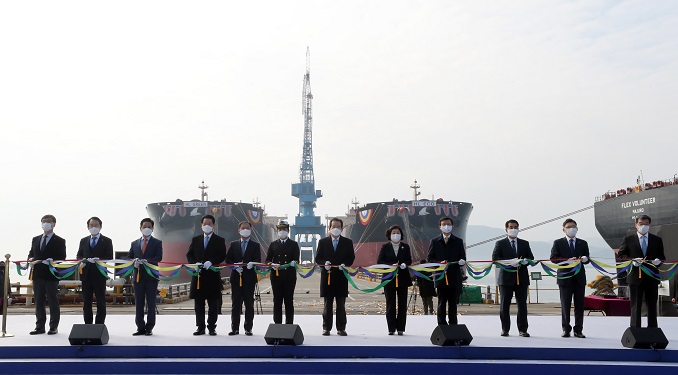SEOUL, Dec. 11 (Korea Bizwire) — South Korea has developed the nation’s first-of-its-kind eco-friendly oceangoing vessel that can reduce the generation of fine dust, one of the main culprits of environmental pollution, by up to 99 percent.
The Ministry of Oceans and Fisheries held a naming ceremony for the nation’s first liquefied national gas (LNG)-powered twin oceangoing ore carriers HL Eco and HL Green at Hyundai Samho Heavy Industries Co. compound in Youngnam County, South Jeolla Province on Friday.
The government extended a subsidy of 9.7 billion won (US$8.91 million) to support the construction of the twin ore carriers under a program to promote the conversion of national-flagged ships into eco-friendly models, aimed at helping the industry cope with the stricter environment regulations of the World Maritime Organization (IMO).
The 180,000 ton oceangoing ore carriers are 292 meters long and 45 meters wide.

A tape-cutting ceremony is held for the launch of the country’s first liquefied natural gas-powered oceangoing ore carriers HL Eco and HL Green at the shipyard of Hyundai Samho Heavy Industries in the port city of Yeongam on South Korea’s southwestern coast on Dec. 11, 2020. (Yonhap)
Instead of using the existing truck-to-ship transfer method that supplies LNG through vehicles on land, the new vessels were built around the ship-to-ship method that pumps fuel from another ship, for the first time in Korea.
The new vessels were built with purely home-grown technology from the stage of design to completion. The localization ratio is 97 percent, much higher than 87 percent for other ships.
Compared to existing ore carriers that use bunker-C oil, they can reduce the generation of fine dust by 99 percent and nitrogen oxide by 85 percent.
J. S. Shin (js_shin@koreabizwire.com)







